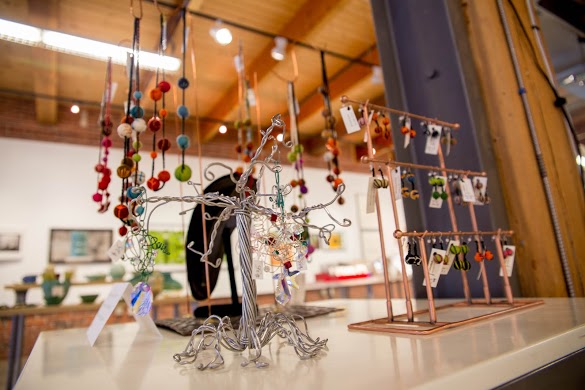By Miharu Sugie, News Staff

In a brick-walled, quaint studio full of ceramics decorated with architectural drawings, artist Nicole Aquillano gently wiped newly glazed mugs as her 8-year-old cat, Luna, licked her paws at her side. The glazed ceramics, inspired by her childhood home in Pittsburgh, are ready to be showcased and sold at Made in Fort Point, a store located a ten minute walk away from Broadway Station.
Aquillano, who moved to Fort Point. a year and a half ago, is one of many artists who came to the area to pursue artistic careers. Many of these local artists are part of the Fort Point Art Community (FPAC), a nonprofit organization and one of the oldest art communities on the East Coast, and contribute to Made in Fort Point.
“I think it’s a great way to showcase the artists that live and work [at Made in Fort Point],” Aquillano said. “Otherwise, people don’t know about us.”
Made in Fort Point was created by FPAC members in 2008. For a long time, FPAC President Jennifer Mecca said that the members wanted to have a pop-up shop that would give artists more opportunities to show their works to the public. Recently, the store was moved to 30 Channel Center St. and is run daily by volunteers and the contributing artists.
A wide range of art is exhibited in the store, including ceramics, textile designs, jewelry, prints, postcards, steel sculptures and childrens’ clothes. FPAC members also meet periodically in the store to discuss plans for events and public art programs.
A major upcoming event is the Open Studio from Oct. 18 to 20, in which the public is welcomed to visit the artists’ studios near Made in Fort Point, see their work and talk to the artists.
Mecca referred to Made in Fort Point as Fort Point’s community center.
“For a lot of our members, it’s time to meet new clients but also some have regular clients who come every year so it’s a chance for them to show off new work and get feedback,” Mecca said. “It’s a place where the neighborhood can come together. We even had some people come in on Sunday mornings because they needed a place to meet for their Spanish class.”
For Aquillano, Made in Fort Point gave her a “community feeling,” in which she can feel comfortable and close to her neighbors within a big city. She decided to end her seven-year career as an engineer to become an artist, and she said she is glad she made the switch in Fort Point – where many other passionate artists, like Linda Huey, reside.
“It’s so hard to be an artist. You can be seen as a crazy person because you’re outside of the average world, because we’re all innovators and independent and we work on our own most of the day,” Huey, a potter, sculptor and FPAC member said. “It’s very nice to know other people are also working alone in their studios. We all value creativity and we all support each other.”
Mecca, a Pittsburgh native, and Huey are not alone. Mecca said a wave of artists settled in Fort Point, creating the FPAC in 1980. These creators “pulled their cash” and bought a few buildings to offer artists cooperative housing and work-spaces, namely 249 A St., 300 Summer St. and Midway Studios, developed in the 1980s, 1990s and 2005, respectively.
However, much of the area in Fort Point that used to be occupied by artists hasve been replaced by high-end businesses and non-artists, according to Alys Myers, a sculptor who joined FPAC in 1994.
“We [used to have] over 600 artists,” Mecca said. “Right now, our membership is about 300 because the neighborhood’s been changing and there have been a lot of developments going on.”
To protect the art communities in Boston, artists including Huey and Myers have joined the Create the Vote Coalition, a group of Boston’s arts and culture organizations led by MASSCreative, and petitioned Boston mayoral candidates to financially support art communities.
“We’re kind of hoping with the new mayor that’s coming in that they might look out for us and help us try to keep our community there because as of now, the community keeps on shrinking because no one’s helping us secure housing,” Myers said.
In addition to more affordable housing and work-spaces, Mecca said that the FPAC members are discussing creating an art center in Fort Point.
“Part of the reason why we want this art center is we really want to get back to having more students because when we lost a lot of rental space down here, we lost a lot of younger generations,” Mecca said. “It’s really nice to have a mix of age groups to shake things up a bit.”
Huey, who is often inspired by nature and environmental issues, said that the diverse FPAC she was exposed to in 1979 helped her grow as an artist.
“I started to realize that artists are important to the city of Boston. It’s part of the cultural identity of this city,” Huey said. “A city needs artists.”









